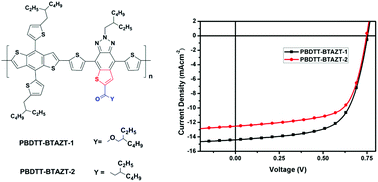Design of a thiophene-fused benzotriazole unit as an electron acceptor to build D–A copolymers for polymer solar cells†
Abstract
A new electron-acceptor, thiophene-fused benzotriazole (BTAZT), is designed for the first time to construct donor–acceptor copolymers with bithienyl substituted benzo[1,2-b:4,5-b′]dithiophene (BDTT) as an electron-donor unit for polymer solar cells (PSCs). Compared with their analogous polymers, which contain a similar conjugated backbone but with the benzotriazole (BTAZ) unit as the acceptor, the BTAZT-based polymers show evident red-shifted absorption with narrower optical band gaps due to the fusion of the thiophene moiety onto the BTAZ unit to further stabilize the quinoid structure of their conjugation backbones. Furthermore, two types of side-chain groups, the alkylcarboxyl group (in PBDTT-BTAZT-1) or alkylcarbonyl group (in PBDTT-BTAZT-2), are introduced to adjust the energy levels and modulate the solubility of the PBDTT-BTAZT based polymers. It is found that the stronger electron-withdrawing ability of the alkylcarboxyl group relative to that of the alkoxycarbonyl group at the α-position of the fused thiophene can further reduce the HOMO energy level to enhance the open voltage (Voc) in the PBDTT-BTAZT-2 based device. PSC devices based on these two polymers as electron-donating materials and a fullerene derivative (PC71BM) as an electron-accepting material are fabricated, and device optimization with additives (DIO or NMP) to modify the morphologies of the active layers and cathode buffer layers (PDIN or PDINO) to modify the cathode interlayers is investigated. The best PCE of approximately 7% is obtained for the PBDTT-BTAZT-1 based device with the DIO additive and PDIN-modified cathode interlayer. Notably, its optimal short circuit current density reaches 14.41 mA cm−2, which is one of the highest values ever reported in BTAZ-based PSCs with a PCBM acceptor. The best PCE of the PBDTT-BTAZT-2 based device also reaches 6.16% with the NMP additive and PDINO-modified cathode interlayer.



 Please wait while we load your content...
Please wait while we load your content...